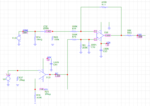sesj13
Newbie level 5
Hello,
I am using a DAC which can output 0V to 3.3V and this goes into an op-amp to boost it to 0V to 10V. This is fed into a unity-gain differential amplifier which also AC-couples in a 1Vpp sinewave. The resulting signal is a 0V to 10V DC level with the sinewave superimposed on it. I need to boost this signal by amplifying its voltage gain by 5 so it is 0V to 50V DC level with a 5Vpp sinewave superimposed on it. This signal will be used to drive a capacitive load of a couple of microfarads, so adequate current gain is also required.
**broken link removed**
I would really appreciate it if you have advice regarding this design or you can recommend any application notes. Thanks.
I am using a DAC which can output 0V to 3.3V and this goes into an op-amp to boost it to 0V to 10V. This is fed into a unity-gain differential amplifier which also AC-couples in a 1Vpp sinewave. The resulting signal is a 0V to 10V DC level with the sinewave superimposed on it. I need to boost this signal by amplifying its voltage gain by 5 so it is 0V to 50V DC level with a 5Vpp sinewave superimposed on it. This signal will be used to drive a capacitive load of a couple of microfarads, so adequate current gain is also required.
- Three voltage rails in the design: 50V, 10V, 3.3V.
- Amplification of DAC level and the differential amplifier are rail-to-rail op-amps supplied from 10V rail.
- Single supply power stage: 50V to GND.
- The power stage must be discrete due to costs in high-voltage op-amps.
- Needs to go close to rails, but a diode drop away is okay.
**broken link removed**
I would really appreciate it if you have advice regarding this design or you can recommend any application notes. Thanks.








